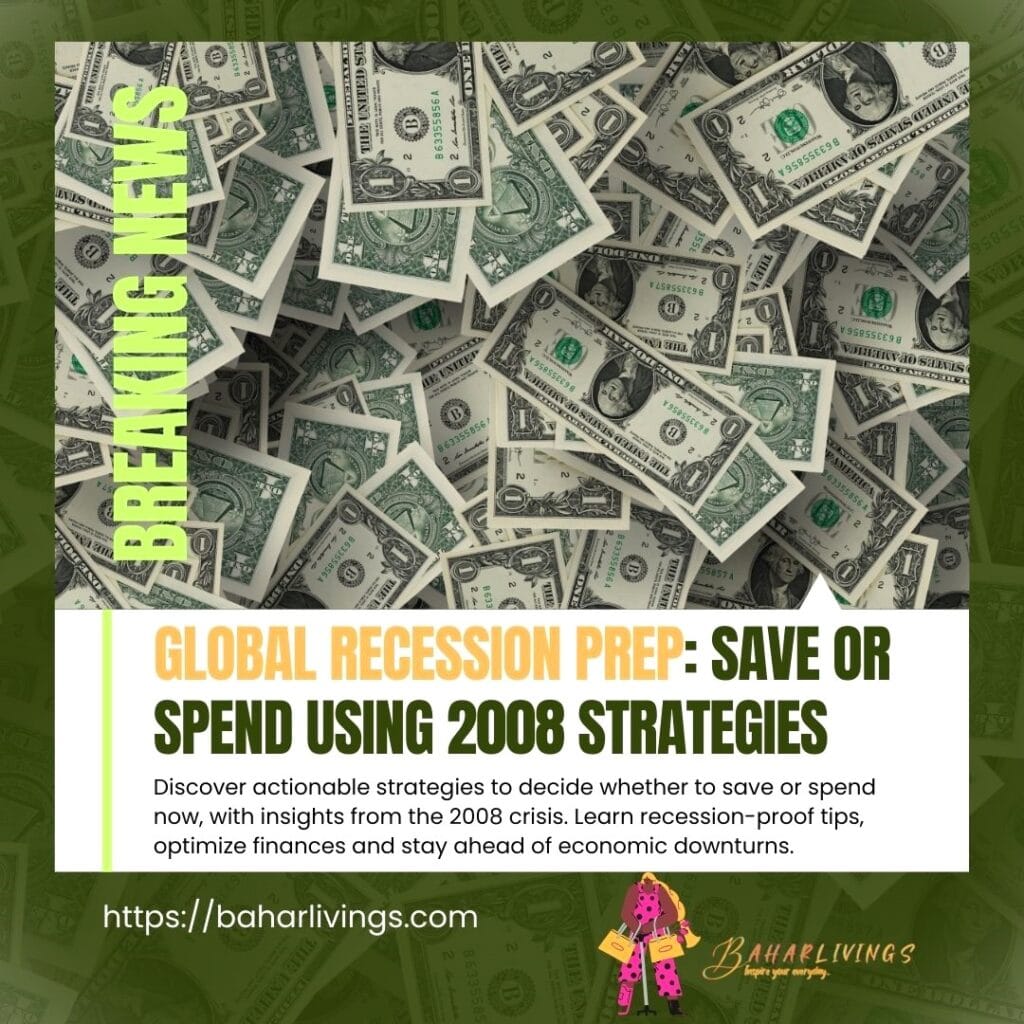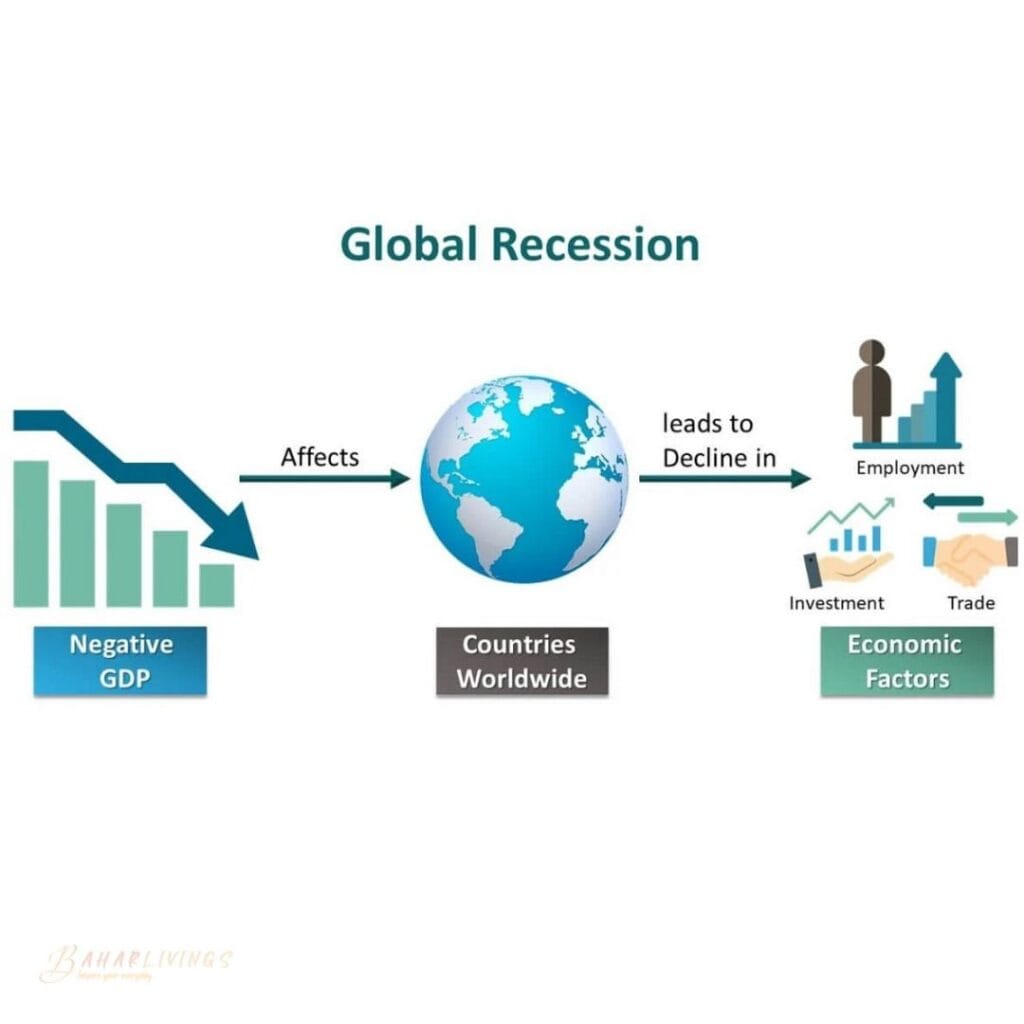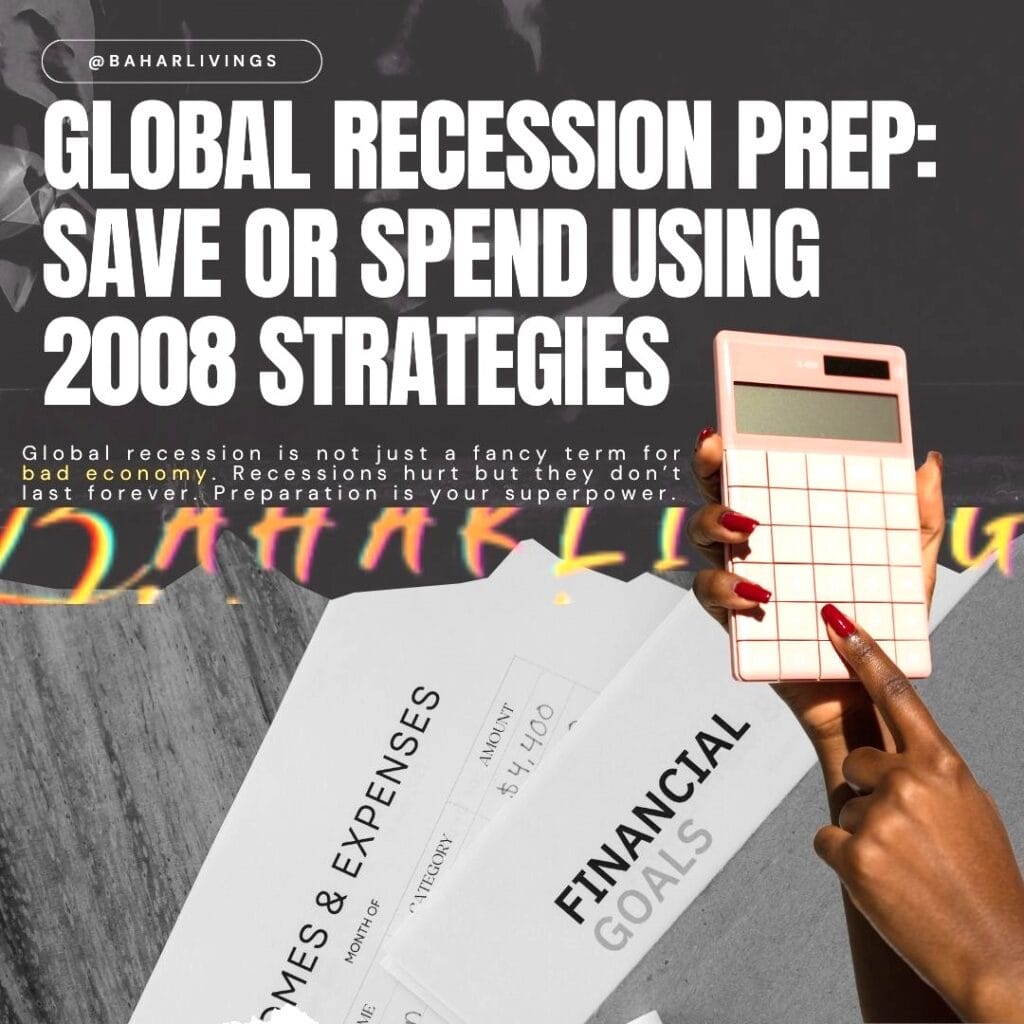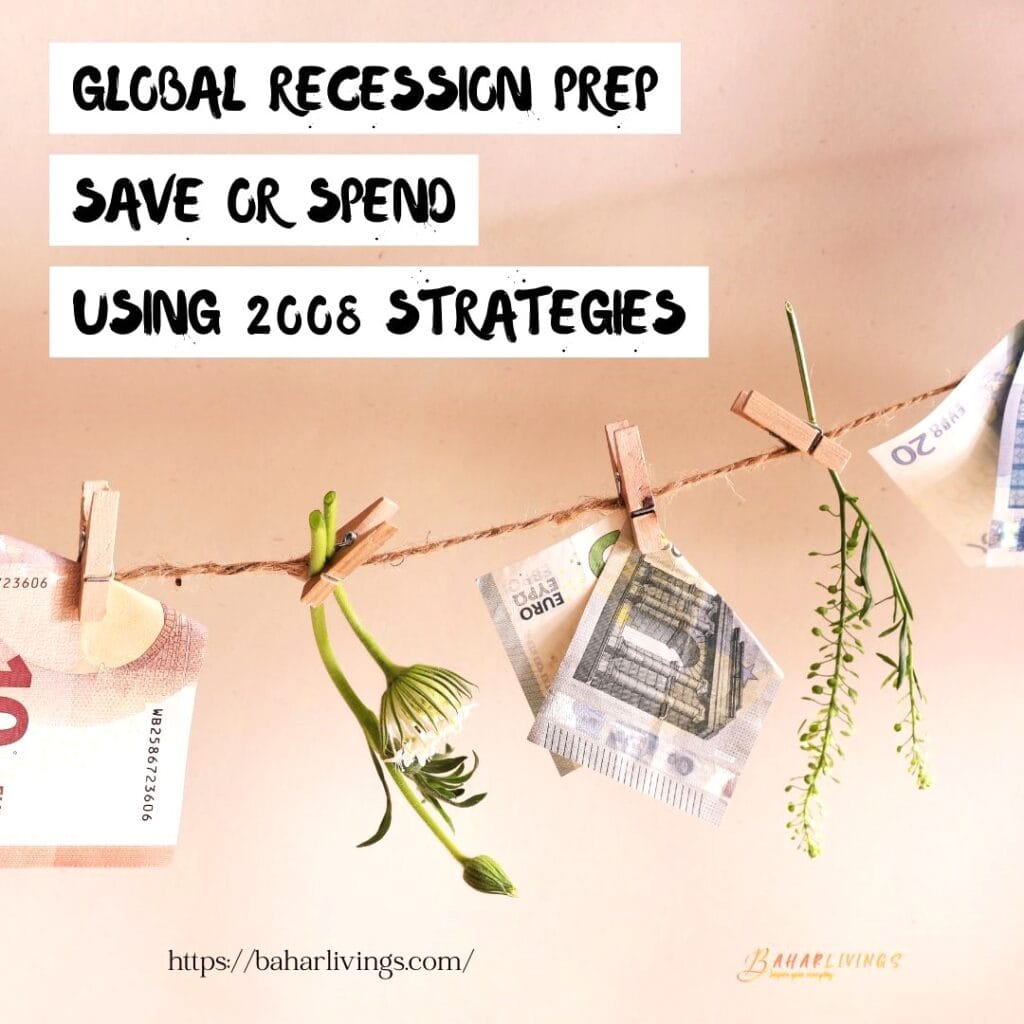Global recession is not just a fancy term for bad economy. Recessions hurt but they do not last forever. Preparation is your superpower.
The First Step to Preparing for a Potential 2025 Global Recession
Assume the following scenario: The news headlines are being scrolled by you. ‘Unemployment in the tech industry reaches record high’, ‘Interest rates rise once more’ or ‘Inflation hits 6%’ Does this sound familiar to you?
Flash back to 2008. Gas prices increased, banks collapsed and panic spread. Today the world feels unstable again. However, your future financial stability may depend on the decisions you make today.
Assume Jony is a 35year old engineer. In 2008, he used all his savings to pay off credit cards, losing the chance to benefit from the stock market recovery.
His friend, Ambar continued to put small amounts in index funds. Her investment portfolio increased double by 2015.
The bottom line is that recessions harm those who are unprepared while benefiting those who plan carefully.
Let us take a look at 2024, the reasons it is similar to 2008 and the steps to take to decide if you should save a lot or spend wisely.
Understanding a Global Recession
A global recession is like a chain reaction of economic slowdowns. When one major country’s economy struggles, the problem doesn’t stay there.
It travels through international trade and financial networks, creating a ripple effect that can pull down economies around the world.
Global recessions are events with large economic and financial disruptions occurring simultaneously in many countries around the world.
During global recessions, financial conditions tend to tighten, business confidence to decline and policy uncertainty to increase.
A worldwide recession begins when economies across the globe start to struggle at the same time. This downturn means entire economies shrink, leading to widespread job losses, people spending less money, and businesses making less profit.
According to the World Bank, a recession is officially defined as a period of economic decline across several economies lasting more than a few months.

Important Indicators of a Recession in the Economy
Slowing GDP Growth: International Monetary Fund (IMF) 2024 GDP forecast show a reduction in global growth from 3.5% in 2022 to 2.9% in 2024.
In developed countries, the United States’ GDP growth is forecast to decrease to 1.5% in 2024, down from 2.6% in 2022, while the Eurozone is expected to increase by only 0.7%.
In comparison, emerging countries like India and Brazil are expected to do a bit better, with growth rates of 6.3% and 2.2%, respectively. However, both rates are still lower than they were before the pandemic.
Rising Consumer Debt: Global household debt-to-GDP ratios have climbed, with the U.S. hitting 80% in 2023, compared to 75% in 2008.
In developing economies, debt levels have also increased with India’s household debt-to-GDP ratio reaching 37% in 2023, up from 27% in 2008.
Similarly, Brazil’s household debt has increased to 52% of GDP, compared to 40% in 2008, reflecting rising financial burdens worldwide.
Manufacturing Slowdown: The Purchasing Managers’ Index (PMI) for important countries like the U.S. and Europe has fallen below 50, indicating that the economy is shrinking.
Furthermore, industrial production growth has slowed dramatically, with the US reporting a 0.7% drop in industrial production in Q3 2023, compared to a 1.2% increase in Q3 2008.
The fact that China’s manufacturing production growth slowed to 3.9% in 2024 from 7.2% in 2008 is indicative of a worldwide trend towards slower economic growth.
Inflation & Interest Rates: The U.S. Federal Reserve has increased interest rates 11 times since March 2022 to fight inflation, which is reducing people’s buying power. Global inflation rates are still unpredictable.
In late 2023, inflation in the Eurozone was 4.3%, while it was 2.3% in 2008. The Bank of England increased interest rates to 5.25% in 2024, the highest level in 16 years, which impacts borrowing prices around the world.
Rising Unemployment: The International Labour Organisation (ILO) says that layoffs are increasing in important areas, particularly in tech and finance.
In early 2024, the latest unemployment trends in the United States was 4.1%, up from 3.5% in 2022 and in the Eurozone, it was 6.6%, up from 6.1%.
Countries like India and Brazil are experiencing more pressure in their job markets and there is a noticeable decrease in casual jobs.

Stock Market Volatility: The S&P 500 fell by 19.4% in 2022, showing that the market was uncertain. It’s like some students in the same class just ace the test.
While many economies had a rough year, India’s Nifty 50 was a top performer, climbing 4.3% in 2023. It goes to show that growth is still happening in different parts of the world.
In 2022, the total value of the global market dropped by $18 trillion, showing that many investors were scared.
Consumer Confidence Index: The Consumer Confidence Index (CCI) dropped to 25.3 in February 2009, reaching one of its lowest levels during the Great Recession.
When individuals lose faith in the economy, they are less likely to spend money, which slows down the economy even more. This is known as a recession.
Housing Market Trends: The current slowdown in the housing market is caused by rising interest rates, unlike in 2008 when the market crashed because of bad debts.
In 2023, the average home price in the U.S. dropped by 5%. In comparison, in 2008, it decreased by almost 12% because of losses and issues with credit.
Corporate Debt Levels: Banks collapsed in 2008 because they were carrying too much debt. Today, corporate debt is higher than ever, at 110% of GDP in developed countries and 75% in developing countries.
This has led to worries about companies failing to pay their debts.
Trade Deficit and Supply Chain Issues: Rising import prices and falling exports have contributed to growing trade deficits in several countries. In 2023, the U.S. trade imbalance grew to $78 billion, up from $45 billion in 2008.
This shows that the country is more dependent on products and services from other countries. Developing countries are facing problems with trade because conflicts between countries have messed up supply chains, leading to lower earnings from exports.
Banking Sector Stability: The current crisis is more about worries about liquidity and stricter credit standards than the one in 2008, which was directly associated with collapsing banks.
There have been few bank collapses, but lending rules have been tightened, making it tougher for people and businesses to get credit and slowing down economic growth.
Commodity Prices and Energy Costs: Crude oil prices dropped in 2008 from a high of $140/bbl as a result of decreasing demand. In 2024, oil prices are unstable because of political issues, fluctuating between $70 and $100 per barrel.
Foreign Exchange Market Instability: The decline in value of currencies is having a major impact on international trade. The value of the US dollar rose relative to the majority of world currencies in 2008.
Due to economic uncertainties, several developing market currencies depreciate by more than 15% in 2024, causing higher volatility.
Consumer Confidence Index: In 2008, consumer trust in major economies dropped to historical lows, delaying economic recovery. Despite surveys showing less spending expectations and more financial conservatism in 2024, consumer mood is still fragile.
Government Deficit and Public Debt Levels: After the 2008 crisis, governments around the world introduced big spending programs, which increased their debt compared to the size of their economies.
By 2024, public debt in big economies has hit all-time highs, which restricts their ability to make financial changes and reduces government support during tough economic times.
Geopolitical Tensions and Trade Wars: Recent international crises, limitations on supply chains and changing economic alignments have increased the likelihood of a recession, as compared to 2008.
Reduced global trade and higher investment uncertainty are consequences of political unrest in critical areas.
Technology Disruptions in Job Markets: Automation and AI are changing job trends, leading to job losses in different businesses that weren’t major issues in 2008.
What Are the Key Differences from 2008 recession
Today’s crisis isn’t a carbon copy of 2008. Adapt your strategy. The 2008 global financial crisis was triggered by the collapse of Lehman Brothers and the housing bubble burst. Banks failed, millions lost their jobs and governments spent trillions to stabilize economies.
While 2025’s situation differs, common factors like inflation, rate hikes and declining consumer confidence raise concerns. Key Differences:
Cause of Crisis: 2008 was driven by banking failures and subprime mortgage collapse, while 2025’s risks stem more from inflation, geopolitical instability and high interest rates.
Government Response: 2008 saw large-scale bailouts; in 2025, central banks are tightening monetary policy instead.
Consumer Debt: Household debt in 2008 was largely mortgage-based, while today’s debt is more concentrated in student loans, auto loans and credit cards.
Global Economic Landscape: The 2008 recession originated in the U.S. and spread globally. In 2025, economic slowdowns are influenced by geopolitical tensions, supply chain disruptions and regional financial instability beyond just the U.S. market.
U.S. Policy on Foreign Financial Aid: Back in 2008, countries worked together by sending emergency money to stabilize the world’s economy.
Now, the U.S. government has decided to pause its financial support to other countries for the next 3 months.
This decision may lead to increased financial instability in emerging markets, reduced liquidity in global trade and further strain on economies reliant on external aid.

Should You Save or Spend During a Recession?
An age-old confusion: save money aside in case something bad happens or spend it to help the economy? Okay, let’s look at the two sides.
1. The Case for Saving: Create an Emergency Fund That Can Withstand Economic Downturns:
Why saving important during economic uncertainty
Smart Saving Strategies
How This Differs from 2008
2. The Case for Spending: Smart Investments and Economic Growth:
Why spending important during economic uncertainty
Smart Spending Strategies
Rule of Thumb: Only spend what you can afford to lose. Patience is rewarded during recessions.
How This Differs from 2008
Important Findings from 2008 for the Year 2025
1. Create a variety of ways to make money.
Overnight, millions of jobs were gone in 2008. Diversifying one’s revenue sources can be achieved through side hustles, freelancing and passive sources of income.
2. Do not panic-sell your investments
Many people lost out on the historic comeback because they sold their stocks at the market price low. Prioritize the long-term benefits and remain invested.
3. Think Before You Borrow Money
In 2008, foreclosures were caused by adjustable-rate mortgages (ARMs). Avoid variable-rate loans and keep your debt to a reasonable amount.
4. Get the Help You Need from the Government, But Make Your Own Plans
Governments helped with loans and incentives, but people need to be able to rely on themselves. Strengthen your financial footing by saving money.
The True Stories of the 2008 Victims: Wins and Tragedies
The Saver: Popyr-ma a nurse, saved 20% of her income pre-2008. When her husband lost his job, their emergency fund covered bills for a year.
The Spender: Carlos put 10 kilos into Apple stock during the crash of 2008. As of 2015, its value had increased to 70k.
The Oops: Dipika sold her 401(k) out of fear in 2009. Within 2020, she lost $200,000 in earnings.
Moral: Balance saves and smart risks.
Save or Spend in 2025? Experts Say It Both Ways
Ray Dalio (Billionaire Investor): The inflationary viewpoint of Ray Dalio’s “Cash is still trash if inflation stays high. Investing in strong assets is the key to preserving wealth and staying ahead in uncertain times.”
Warren Buffett (Berkshire Hathaway CEO): The economic downturn investment strategy of Warren Buffett “Be fearful when others are greedy and greedy when others are fearful.”
Opportunities frequently arise when uncertainty peaks and this wise counsel emphasizes the significance of making strategic decisions during economic downturns.
Janet Yellen (U.S. Treasury Secretary): “Moderate spending and smart investing help stabilize personal finance in uncertain times. Making informed financial choices today can safeguard your future and turn economic uncertainty into an opportunity for growth.”
Finally, What Is the Best Course of Action
Economic downturns are temporary.
The behaviors you form now, such as saving aggressively, spending wisely and remaining agile, will continue far beyond any headline.
A recession is not just a challenge but also an opportunity to build wealth and financial resilience.
By learning from 2008, we can navigate today’s uncertainty with confidence.
Frequently Asked Questions (FAQs) and Answers
What Are the Biggest Risks to Avoid During a Recession?
Many types of financial risks are heightened in a recession. This means that you’re better off avoiding some risks that you might take in better economic times—such as co-signing a loan, taking out an adjustable-rate mortgage (ARM) or taking on new debt.
Who benefits from a global recession?
Any person who has been able to save money while also staying out of debt is capable of benefiting from a down turn in the market. The cost for property is one of decreases significantly during times of recession and this creates what is known as a buyer’s market.
How long do recessions last?
The good news is that recessions generally haven’t lasted very long. Our analysis of 11 cycles since 1950 shows that recessions have persisted between two and 18 months, with the average spanning about 10 months.
What increases in value during a recession?
A recession is a significant, widespread and extended decline in economic activity. Riskier assets like stocks and high-yield bonds tend to lose value in a recession, while gold and US Treasuries appreciate.
Are we in a recession in 2025?
UN Trade and Development (UNCTAD) projects global economic growth at 2.6% in 2024, narrowly avoiding the 2.5% recession threshold. This marks the third consecutive year below pre-pandemic averages (3.2% from 2015–2019). Despite fears, no recession followed in 2024. Wall Street’s gloomy GDP forecasts missed the mark for two straight years, as global growth outpaced expectations.
Updated projections now include 2025 alongside 2023 and 2024 data, highlighting economists’ persistent overcaution amid shifting economic realities.


“Great content, learned a lot from this post!”
“Well explained, made the topic much easier to understand!”
“I appreciate the detailed explanation, very helpful!”